Monsters of Conliah
After repeated exposure to Cthonic energy, you are guaranteed to develop a faint synesthesia for its presence. Some describe a literal red glow, and others report the faint smell of burning garlic. Regardless of how it manifests, what is indispensible is to trust your senses and instincts. Once Cthonic energy is detected, it is necessary to take decisive action. A first strike can make the difference between life and death.
-- The Inquisitorial Field Manual of Iazus
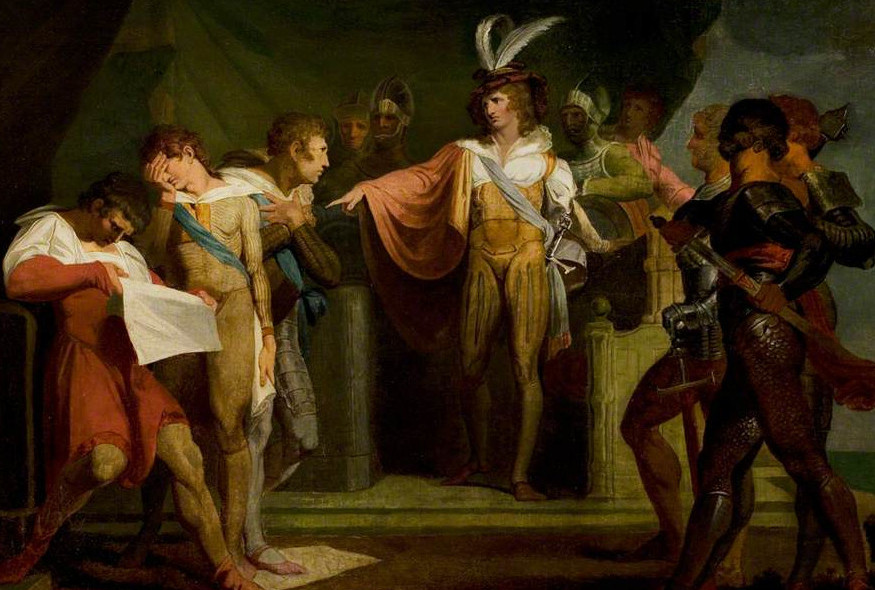
Note that Conliah lacks two distinct categories of monsters: "always evil humanoids" and "magical beasts". While classic mythological creatures may be present in Conliah in some form, they must be reimagined as belonging to one of the below categories outlined.
The below listing provides several traits, which help to contextualize what an encounter with the monster is like:
- Robustness refers to the overall resilience of the monster in combat, by analogy with a real-world animal.
- 0: Frailer than an untrained, sentient humanoid
- 1: Baseline for untrained, sentient humanoids
- 2: Domestic Mule
- 3: Wild Boar
- 4: Black Bear
- 5: Grizzly Bear
- 6: Cape Buffalo
- 7: American Bison
- 8: Black Rhinoceros
- 9: African Elephant
- 10: Resilient beyond analogy
- Number appearing provides a range for how many monsters are present in a random encounter.
- Disposition may be peaceful, cautious, or hostile. It refers to the default, unprovoked friendliness of the monster.
- Courage may be relentless, brave, pragmatic, or cowardly. It refers to the willingness of the monster to fight to the death.
- Soul color describes the magical signature that the monster's presence emits.
- Intelligence may be mortal-like, animal-like, or automaton-like. It refers to whether the monster is capable of social interaction and improvisation.
Corrupted Mortals
These common monsters are former mortals, who were corrupted by Cthonic forces in life, or in death. Corrupted mortals enact the will of the Archons, whether they want to or not. For their common fear of being persecuted by the sentient mortal races on the surface, these corrupted mortals will often settle in the same underground complexes such as Magellian ruins and caves. The different groups of corrupted mortals do not necessarily trust each other, but avoid conflict with one another in order to survive.
Gutterplots
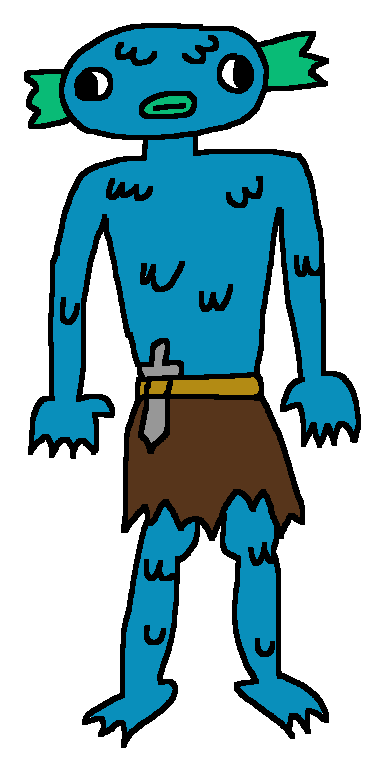
- Robustness: 1
- Number appearing: 2-8
- Disposition: Hostile
- Courage: Cowardly
- Soul color: Green core, with traces of red
- Intelligence: Mortal-like
Mortals who seek Inizozim's blessing for vengeance may be turned into a Gutterplot. Gutterplots grow fish scales all over their body, and gain the ability to breathe underwater, in addition to being able to breathe air. Their faces widen and their eyes begin to drift apart. After taking vengeance, Gutterplots often live in fear of retribution towards themselves in turn. Gutterplots are afraid of melee combat, preferring to use cunning tricks to gain an advantage. They plan surprise attacks on innocent travelers for fear that they are the friends and family of those they wronged.
Husks
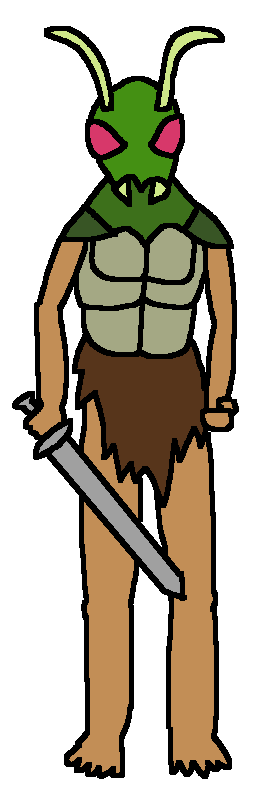
- Robustness: 2
- Number appearing: 1-6
- Disposition: Cautious
- Courage: Pragmatic
- Soul color: Green core, with traces of red
- Intelligence: Mortal-like
Mortals who seek Ulviazing's blessing for blissful dreams may be turned into a Husk. Husks grow to seven feet tall, and they grow an insect carapace all over their torso. Their arms and legs remain as they were, without insect features. Husks have faces that look like grasshoppers. Due to their Cthonic corruption, Husks dream even when they are awake. Oftentimes they do not intend to initiate combat, but due to their confusion feel they are under attack. Nonetheless, Husks retain their intelligence and strategic capabilities after transformation. Groups of Husks roam the wilderness wielding weapons for use in self-defense.
Zoners

- Robustness: 1
- Number appearing: 1-3
- Disposition: Peaceful
- Courage: Cowardly
- Soul color: Green core, with traces of red
- Intelligence: Mortal-like
Mortals who serve Ogzim may be transformed into Zoners. The only apparent effect of this transformation is permanent, complete invisibility. This invisibility covers all body parts, but it does not effect clothing, weapons, jewelry, etc. that the Zoner possesses. In general, Zoners are not combatants and they prefer to use their newfound power for personal material gain. However, their invisibility isolates them from living in normal society, often undermining their original motivation to gain social advantage through invisibility.
Draklings
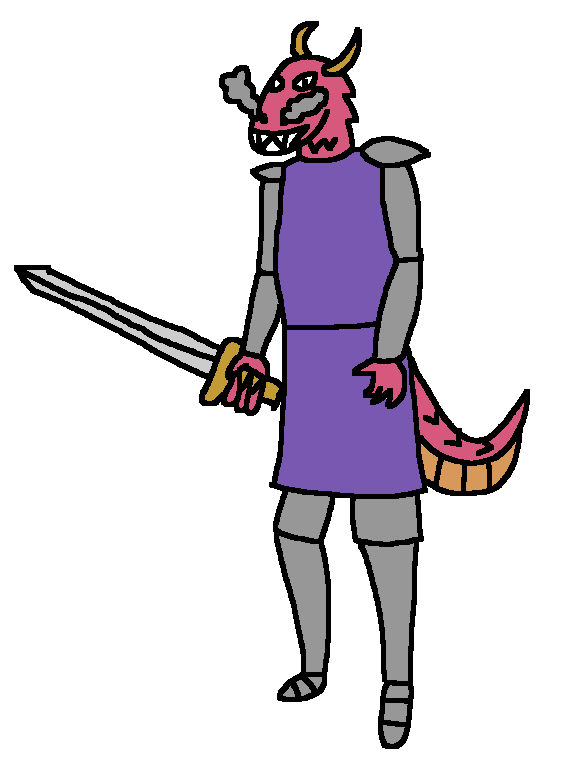
- Robustness: 1
- Number appearing: 2-8
- Disposition: Cautious
- Courage: Cowardly
- Soul color: Green core, with traces of red
- Intelligence: Mortal-like
Mortals who seek Lundazing's blessing in a revolutionary plot may be gifted with transformation into a Drakling. They grow reptilian scales, tails, and curved horns. They gain the ability to breathe fire or acid. Draklings are cunning, but prefer to avoid direct combat in melee range. Instead, they tend to use ranged weapons, lay traps, and ambush their enemies. Draklings are usually former nobles and their loyal courts. The goal of most Draklings is to usurp their superiors and rule over the land. Even if they successfully kill their superiors, their monstrous transformation undermines their legitimacy and authority.
Iavols
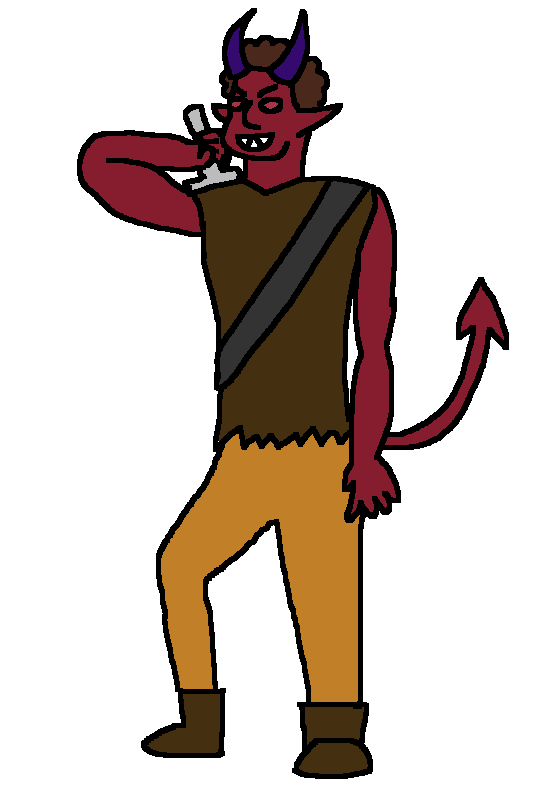
- Robustness: 1
- Number appearing: 2-8
- Disposition: Hostile
- Courage: Pragmatic
- Soul color: Green core, with traces of red
- Intelligence: Mortal-like
Mortals who worship Lize in hopes of conquering Conliah may be gifted with transformation into an Iavol. Their skin turns red, and they grow horns and a barbed tail. They gain the ability to induce unbearable pain in others. Iavols are bent on war and domination. When Iavols invade a region, they establish a lair to launch attacks on the country side. They raid settlements to loot weapons, armor, and rations.
Doombinders
- Robustness: 3
- Number appearing: 1-4
- Disposition: Hostile
- Courage: Brave
- Soul color: Green core, with traces of red
- Intelligence: Mortal-like
Mortals who worship Uluzing through a long career of assassination may be gifted with transformation into a Doombinder. Their skin turns pitch black, and their bodies emit plumes of smoke. The smoke makes it very difficult to see exactly where Doombinders are, when attacking them. In addition to becoming stronger, they gain the ability to curse a single mortal in their presence: if the Doombinder dies, then the cursed person simultaneously dies. The curse is permanent unless magically lifted, and the Doombinder may transfer the curse to another mortal at will.
Lycanthropes
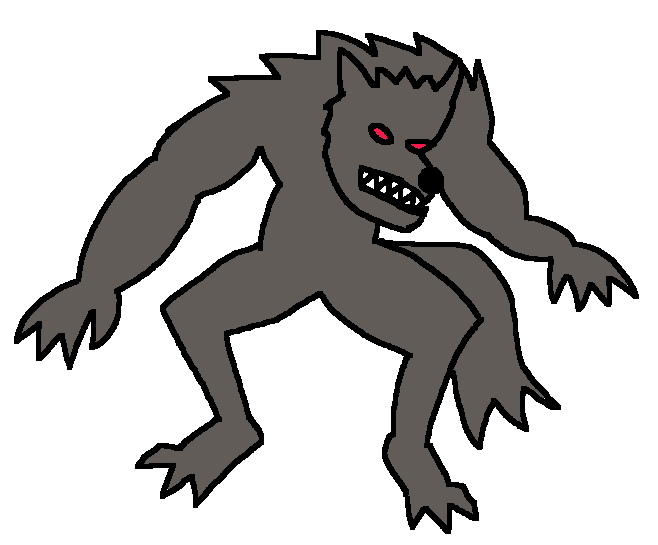
- Robustness: 4
- Number appearing: 1-6
- Disposition: Cautious
- Courage: Pragmatic
- Soul color: Green core, with floods of red
- Intelligence: Mortal-like
Lycanthropy is a disease that spreads through a bite or claw attack from the infected. Unless cured, the infected becomes a Lycanthrope within 3-18 days. By contracting the disease, Lycanthropes gain the power to transform themselves at-will into an animal-human hybrid form. In addition, they are involuntarily transformed into their animal-human hybrid form upon the waxing gibbous moon, and revert back to their mortal form upon the waning gibbous moon. Which animal the Lycanthrope resembles upon transformation is based on the form of Lycanthrope who caused the infection. Lycanthropes fully retain their intelligence and memories upon infection. While transformed into their animal form, their minds are polluted by an insatiable hunger for the flesh of mortals. Contracting Lycanthropy has no effect on the infected mortal's outward appearance when untransformed. The Archon Nabazie is the original source of all Lycanthropes.
Laffids
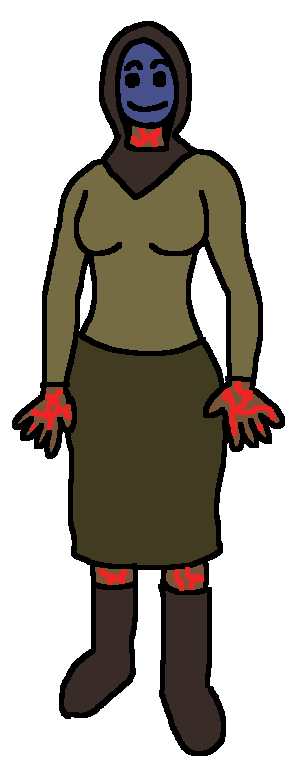
- Robustness: 4
- Number appearing: 1-6
- Disposition: Cautious
- Courage: Brave
- Soul color: Green core, with traces of red
- Intelligence: Mortal-like
Mortals who worship Lozie may be transformed into a Laffid. Their physical form becomes warped and repulsive, as if their skin has melted and boiled, leading them to wear wooden masks to conceal their faces. Their transformation also makes Laffids physically strong and fast. In addition, their transformation allows them to temporarily shape-shift into any humanoid, sentient mortal they choose to resemble. This shape-shifting may be sustained for several hours, but requires an equal amount of time to rest in between impersonations. Laffids tend to use their powers of impersonation to cause social discord. However, while in their true form they live in constant fear of being mocked for their revolting faces.
Pertinaxes
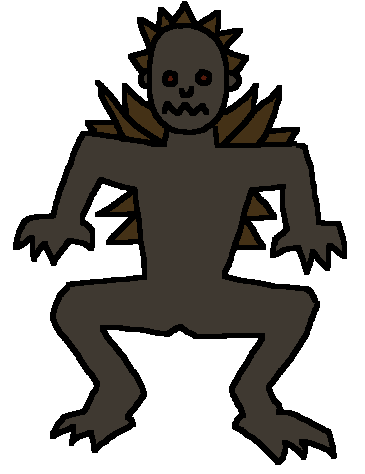
- Robustness: 5
- Number appearing: 1-4
- Disposition: Peaceful
- Courage: Relentless
- Soul color: Green core, with floods of red
- Intelligence: Mortal-like
Mortals who seek Dreze's blessing for the endurance to complete a task may be transformed into Pertinaxes. A Pertinaxe's skin turns to stone, and large stone spikes grow out of its back. The transformation changes the mind of the Pertinaxe into a being single-mindedly committed to the completion of a single task. Their specific behavior depends on what the mortal was originally petitioning Dreze for strength with. Once the task is complete, the Pertinaxe is doomed to repeatedly attempt to complete the same task, regardless of whether it is still meaningful. The metabolism and digestion of the Pertinaxe also changes significantly. They move substantially slower, but have greatly reduced food and water requirements. They become capable of extracting nutrition from stones and soil, which their hands are capable of breaking and digging into. They have total disregard for social norms, and will opportunistically engage in cannibalism of sentient mortals. However, they do not rely on hunting to survive as they can exclusively live on stones and soil. Pertinaxes still retain their intelligence and memories. They are capable of holding a conversation, and engaging in long-term planning. However, Pertinaxes will completely ignore what is happening around them until it is either useful to them or an obstacle to achieving their task. If combat is required to achieve a Pertinaxe's goal, it will resort to fighting. However, Pertinaxes move slowly and lack ranged attacks, making them easy to flee. Once close enough, they strike with their sharp claws.
Sunspawns
- Robustness: 2
- Number appearing: 1-4
- Disposition: Peaceful
- Courage: Pragmatic
- Soul color: Green core, with traces of red
- Intelligence: Mortal-like
Mortals who seek Omuzast's blessing for magnetic beauty may be transformed into Sunspawns. Their skin glows radiantly, causing uncorrupted mortals around them to be instantly attracted them. However, those who are compelled to walk close to a Sunspawn begin to feel confused. This confusion can cause others to feel dizzy, wander around, or attack wildly. Sunspawns tend not to worry about the confusion they cause, and continue to use their power to draw attention to themselves. As a result, the time lapse between becoming a Sunspawn and being killed by inquisitors is uniquely short. Sunspawns usually do not seek to fight, but they will violently resist any attempt to restrain the use of their gift. Sunspawns have the ability to project blasts of elemental sunlight at their enemies, and often use simple weapons like daggers to defend themselves.
Troggles
- Robustness: 4
- Number appearing: 2-12
- Disposition: Hostile
- Courage: Cowardly
- Soul color: Green core, with floods of red
- Intelligence: Mortal-like
Mortals who seek Embe's blessing for freedom from obligation may be transformed into Troggles. They begin to walk on all fours, develop a hunched back, and lose their vision. The transformation also grants sharp claws and teeth. Troggles become very timid, and seek to escape by burrowing underground. Troggles find each other and establish larger underground burrows. They periodically leave their burrows to hunt animals. They have an incredible sense of smell, which makes them excellent hunters despite their loss of vision. They retain their intelligence and memories, but become uncontrollably terrified of civilized mortals. They are more likely to run away than to fight, but when pressed they will use their claws and teeth in self-defense.
Cthonians
These exotic monsters originate in Cthonia, and cannot persist in Ksylia for prolonged periods. Summoners aligned with an Archon may temporarily summon a Cthonian as an ally in battle, without a Cthonic Breach. However, seeing any of these monsters wandering in the open without a summoner is a sure sign of a Cthonic Breach.
Cthonians have three types of intelligence: mortal-like, animal-like, and automaton-like. Mortal-like Cthonians can carry out conversations and recall past experiences. Animal-like Cthonians act according to their raw instincts, which are typically predatory. Automaton-like Cthonians are limited to repeating a small set of behaviors.
Lykoids

- Robustness: 2
- Number appearing: 3-18
- Disposition: Hostile
- Courage: Pragmatic
- Soul color: Red
- Intelligence: Mortal-like
Lykoids are two-legged humanoids with the bodies of ordinary humans without fur, but the faces of wolves. They are native to Nabazie's sphere of Howling Hall, where they endlessly chase prey animals around the halls. Their society is based on packs led by a hierarch. Lykoids fight by grabbing their targets, and using their powerful jaws to bite. They prefer to move in packs, and swarm their enemies.
Nightcreeps
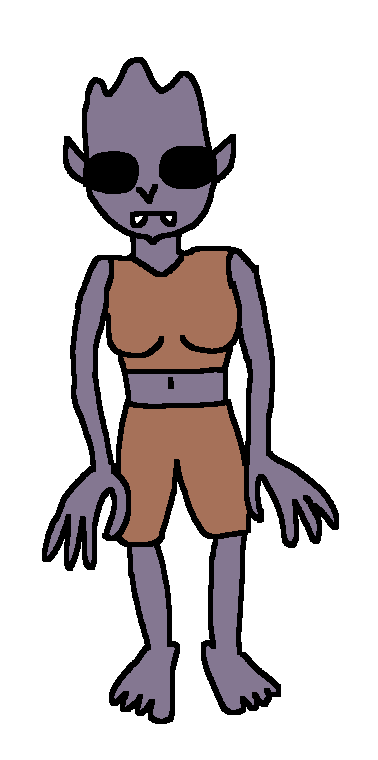
- Robustness: 1
- Number appearing: 1-8
- Disposition: Cautious
- Courage: Cowardly
- Soul color: Red
- Intelligence: Mortal-like
Nightcreeps are short, three-foot-tall humanoids with eerie faces with abnormally large, pitch-black eyes. They are native to Ogzim's sphere of the Starless Abyss, where they live on permanent wooden rafts that float across a pitch-black ocean. They are very stealthy, but are afraid of bright lights. Proximity to a Nightcreep gradually dulls all of one's senses. After several minutes of exposure, those affected instantly die.
Oktocheirs
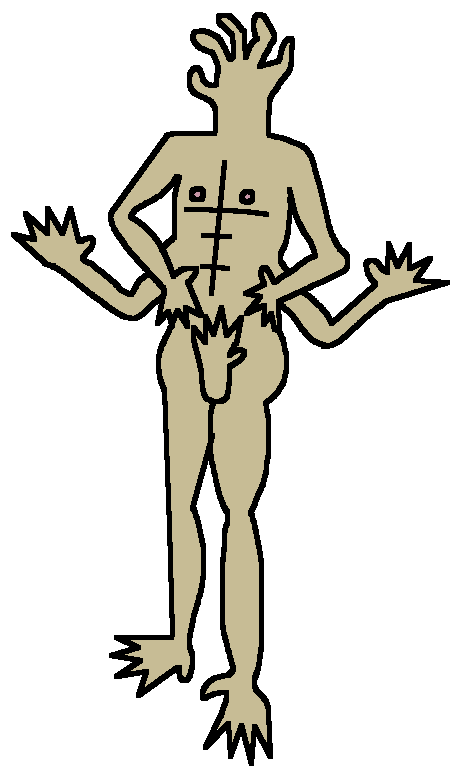
- Robustness: 10
- Number appearing: 1-4
- Disposition: Hostile
- Courage: Relentless
- Soul color: Red
- Intelligence: Animal-like
Oktocheirs are fifteen-foot-tall creatures who are composed of Human torsos with eight arms, no legs, and no heads. In the absence of eyes or ears, Oktocheirs can detect where mortals are positioned based on the vibration of their footsteps, however subtly their prey attempts to sneak. They can move in different ways, often either by crawling on all eight arms like a spider, or by walking on two arms like humanoid legs. They are native to Uluzing's Quaking Peaks, where they threaten to push or throw travellers onto either side of a narrow cliff.
Tentacle Heads
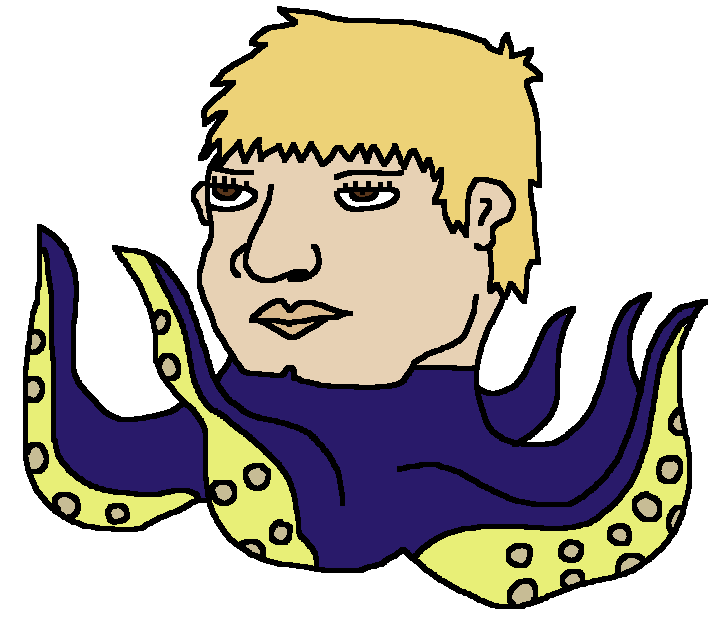
- Robustness: 10
- Number appearing: 1-4
- Disposition: Cautious
- Courage: Brave
- Soul color: Red
- Intelligence: Mortal-like
Tentacle Heads are ten-foot-tall Human heads with eight tentacles attached at the neck. They levitate in the air, and have the power to read thoughts. They are native to Igedeng's Deadwoods, where they compile knowledge of the world by probing the thoughts those visiting the Deadwoods. Tentacle Heads primarily fight by grappling and crushing their opponents with their tentacles.
Microdragons
- Robustness: 0
- Number appearing: 6-60
- Disposition: Hostile
- Courage: Cowardly
- Soul color: Red
- Intelligence: Animal-like
Microdragons are three-foot-long lizards who breathe weak blasts of fire and bite with sharp teeth. Microdragons are also capable of using simple and improvised weapons. They are not very intimidating alone, but when encountered in swarms have the ability to cause enormous destruction. Microdragons lack a fighting spirit, and tend to flee at the first sign of real danger. Microdragons are the lowest caste in Lundazing's sphere of Cinderthrone, and constantly rebel against their superiors the Drakes.
Drakes
- Robustness: 3
- Number appearing: 3-18
- Disposition: Hostile
- Courage: Pragmatic
- Soul color: Red
- Intelligence: Mortal-like
Drakes are bipedal reptiles standing at eight feet tall who can breathe fire. They are broad and strong, and have powerful wings capable of flight. Drakes often wield melee weapons and javelins, but often switch between these weapons and their natural claws, teeth, and breath weapons. Drakes march into battle more confidently than Microdragons, who they command as cannon fodder. In Lundazing's sphere of Cinderthrone, Drakes stand above Microdragons but below all other castes. Often times, Drakes will band with either Dragonsnakes or Drakotherians to demote the other caste, in order to earn the spoils of siding with the victor.
Dragonsnakes
- Robustness: 5
- Number appearing: 2-12
- Disposition: Hostile
- Courage: Pragmatic
- Soul color: Red
- Intelligence: Mortal-like
Dragonsnakes are limbless ten-foot-long reptiles with powerful jaws, who are capable of breathing fire. They are very good at burrowing underground and ambushing their enemies. Dragonsnakes are patient and calculating in their approach to battle. Dragonsnakes are native to Lundazing's sphere of Cinderthrone, where they rank above Drakes but below Dragons. Whether Drakotherians rank above or below Dragonsnakes varies between Dragon kingdoms, and their relative positions are constantly switching. When Dragonsnakes rank above Drakotherians, the Dragon kingdom tends to take an underhanded approach to battle.
Drakotherians
- Robustness: 8
- Number appearing: 2-12
- Disposition: Hostile
- Courage: Brave
- Soul color: Red
- Intelligence: Mortal-like
Drakotherians are fifteen-foot-long lizards who reside in Lundazing's Cinderthrone. In battle, Drakotherians have two main weapons: a potent fire breath, and club tails covered in spikes. Drakotherians are proud combatants who must demonstrate courage in battle to maintain rank within their own caste. Drakotherians rank above Drakes but below Dragons. Dragon kingdoms vary in whether Drakotherians outrank Dragonsnakes or not. When Drakotherians are the most dominant caste next to Dragons, the Dragon kingdom tends to take a straightforward approach to battle.
Dragons
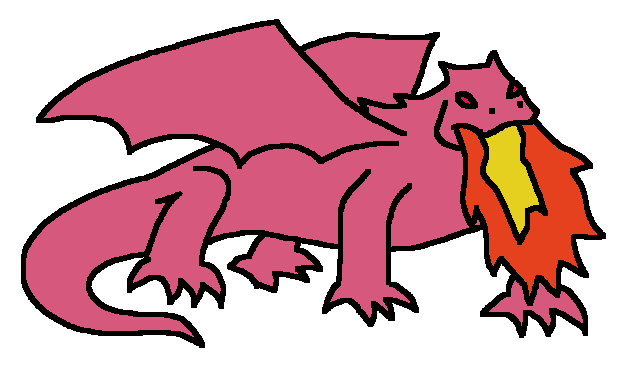
- Robustness: 10
- Number appearing: 1-4
- Disposition: Hostile
- Courage: Brave
- Soul color: Red
- Intelligence: Mortal-like
Dragons are enormous, fire-breathing, winged reptiles who reside in Lundazing's Cinderthrone. The largest Dragons may be fifty feet long. They have a well-defined social hierarchy in which the leader of a Dragon kingdom is constantly being overthrown by their subject Dragons. They rule over other lesser Dragon-like beings who populate Cinderthrone who exist at lower strata of this social hierarchy. According to legend, the ancient Dwarves who worshipped Lundazing were granted the power to summon Dragons as flying mounts.
Tormentors
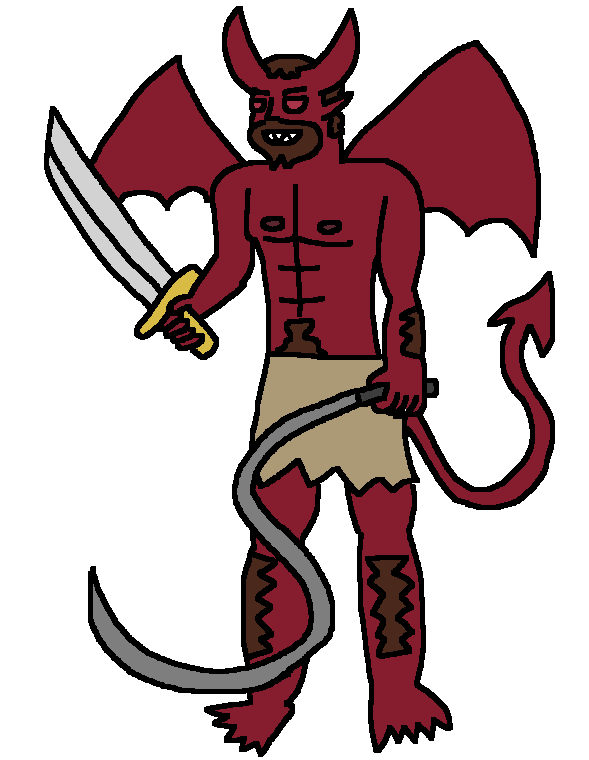
- Robustness: 10
- Number appearing: 1-4
- Disposition: Hostile
- Courage: Relentless
- Soul color: Red
- Intelligence: Mortal-like
Tormentors are eight-foot-tall muscular humanoids with horns, crimson skin, leathery wings, and hooked tails who reside in Lize's sphere of the Reaping Grounds. Tormentors use implements of torture to inflict unspeakable pain on mortals who phase into her Reaping Grounds.
Holders
- Robustness: 0
- Number appearing: 1
- Disposition: Hostile
- Courage: Cowardly
- Soul color: Red
- Intelligence: Mortal-like
Holders are native to Lize's sphere of the Reaping Grounds. Holders are unusual for Cthonians, in that they phase out of Ksylia within one second or so while in their true form. Even in Cthonia, Holders merely appear as a plume of thick white smoke, are easily physically destroyed, and have no physical abilities. Instead, the main ability of Holders is to immediately possess the body of an animal or a sentient mortal upon entry into Ksylia. Possession is not guaranteed, but depends on the Holder successfully wrestling with the soul of the possessed. Holders are quite fast in their true form, allowing them to move about 30 feet per second. This grants them about a 30 foot radius where they may take possession of someone before phasing out of Ksylia. The exact effect is different depending on whether an animal or sentient mortal is possessed.
When a Holder possesses an animal body, the animal's soul is instantly destroyed and dissipates into Ksylia. If the animal was quadrupedal, it may choose to stand bipedally sometimes. If the Holder is exorcised out of the animal's body, the animal's body simply dies. The most common use of animal possession is for the Holder to act as a discreet servant for the Invoker who summoned it. However, the Holder is not inherently loyal to the Invoker, and obeys the Invoker based on shared obedience to Lize.
When a Holder possesses a sentient mortal's body, the sentient mortal's soul is instantly phased into Lize's sphere of the Reaping Grounds and inhabits a temporary physical body which resembles the sentient mortal's original body. This temporary physical body then becomes subject to torture at the hand of Tormentors. If the Holder is exorcised out of the sentient mortal's body, then the sentient mortal's soul instantly phases out of Lize's sphere back into its original body, alive and well as it was just prior to exorcism. The temporary body in the Reaping Grounds then disintegrates. If the sentient mortal's body dies while possessed, then its soul remains permanently in the Reaping Grounds.
Other aspects of possession are identical between animals and sentient mortals. The Holder takes full control of the possessed being's body, and the Holder may do so indefinitely without the usual restriction of being forced to phase back into Cthonia. During possession, the possessed being exclusively speaks in Lize's language, and animals gain the ability to do so. The possessed being still needs to perform all of its ordinary activites like eating and drinking to continue living. The possessed creature retains its physical strength and speed. The Holder may cast simple offensive magic while possessing a host, but is not extremely magically powerful in combat.
Holders have the ability to abandon a host. This mostly has the same effect as exorcism, in its consequences for the abandoned host. However, exorcism forces the Holder back into Cthonia, whereas abandonment gives the Holder the opportunity to repossess a new host. A Holder cannot use abandonment to dodge a successful exorcism. The exorcism "yanks" the Holder into Cthonia regardless of its immediate host. Abandonment also fails if the current host is already dead before the Holder chooses to flee. Killing the host forces the Holder back into Cthonia. After abandonment, failure to wrestle with the new host's soul also forces the Holder back into Cthonia, without a second chance.
Holders are sadistic and enjoy taunting their enemies from a position of dominance, but feel genuine fear of banishment. They prefer self-preservation of their hosts over being forced back into Cthonia. Holders avoid sacrificing or abandoning their hosts unless backed into a corner, even if it would offer a tactical benefit. A Holder who possesses a sentient mortal's body feels the most confident when it knows its adversaries refuse to kill the host and do not have access to exorcism magic.
Nagas
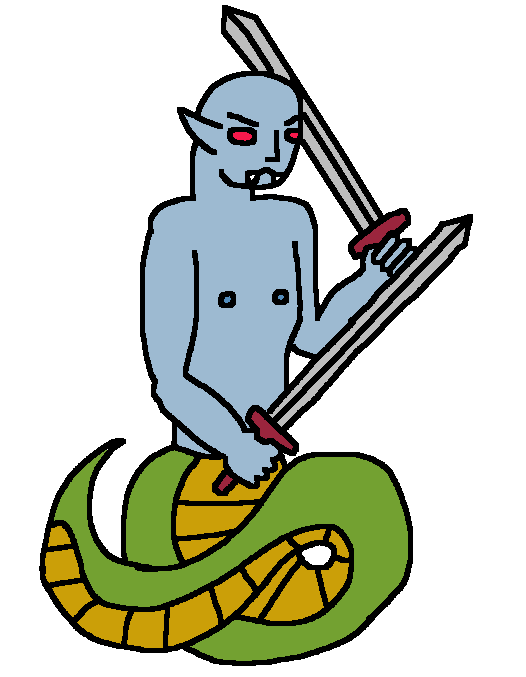
- Robustness: 4
- Number appearing: 3-18
- Disposition: Cautious
- Courage: Brave
- Soul color: Red
- Intelligence: Mortal-like
Nagas are creatures with the upper body of a human and the lower body of a snake. They can hold their breath underwater for hours at a time. They lurk in Inizozim's Mirror Marshes, where they meticulously balance the weight of logs sitting on rocks. Nagas will not hesitate to strike anyone who disturbs the weight of one of the logs. They are very fast when slithering or swimming, and they typically wield two longswords to strike their opponents.
Arachnaurs
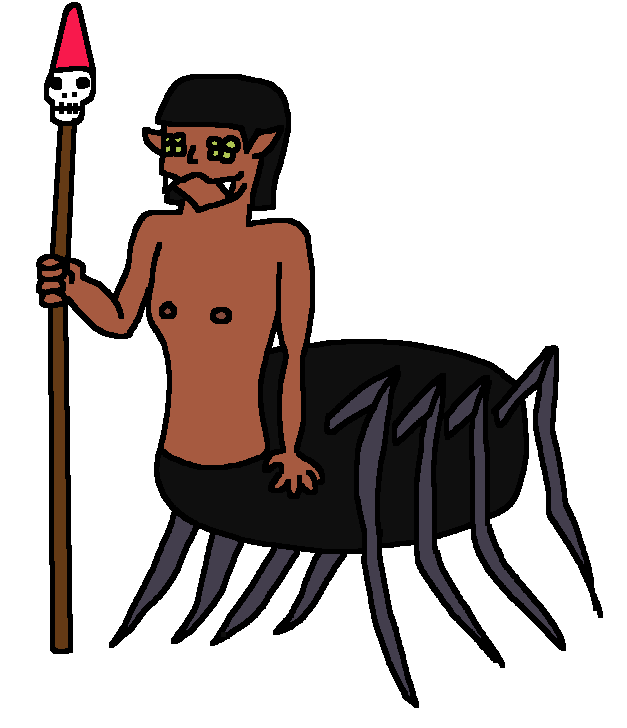
- Robustness: 9
- Number appearing: 1
- Disposition: Peaceful
- Courage: Brave
- Soul color: Red
- Intelligence: Mortal-like
Arachnaurs are centaur-like creatures with the upper body of a human and the lower body of a spider. They are highly magically inclined. Arachnaurs lurk in Ulviazing's Blissful Hollow, a land of petrified trees. Arachnaurs spin webs and play them like instruments. They are friendly to intruders at first, but Arachnaurs expect their audience to applaud the performance. Those who do not applaud become immediate enemies of the Arachnaurs. Arachnaurs fight with magical spells, which include a combination of elemental blasts and mental control such as forcing opponents to act aggressively towards their own allies.
Pulsecutters
- Robustness: 5
- Number appearing: 1-4
- Disposition: Hostile
- Courage: Brave
- Soul color: Red
- Intelligence: Mortal-like
From the outside, Pulsecutters appear to be amorphous masses of knives pointed outwards, standing at three feet tall. The only opening in this shell of knives reveals two glowing red eyes. Pulsecutters move by extending a temporary pseudopod to crawl. The true bodies of Pulsecutters are a tangled web of slimy black cords that are so densely packed that they form a solid mass. The ends of these black cords firmly hold the handles of the exterior knives. A single knife may be extended approximately three feet away by extending the cord that holds that knife. In general, each cord has total freedom of motion, but the constriction on their interior prevents Pulsecutters from extending multiple knives at once. Pulsecutters live in Eovumid's sphere, the Apothecary of Knives, which is an endless row of prison cells on either side. The Pulsecutters guard the halls, and visit each of the prisoners one at a time. Pulsecutters gently extend one of their cords to cut the prisoners with their knives, slowly poisoning them to death. Cuts from their knives are not very immediately dangerous, but they inject their victims with a slow-acting poison that kills them. The poison also causes incredible pain to the victim. Each additional cut increases the potency of the poison, which reduces the time until death. Pulsecutter Toxin is different from Blood Monstrosity, but if a Pulsecutter cuts a Blood Monster, then there is a chance it will transmit Blood Monstrosity at the same time.
Fluttermice
- Robustness: 2
- Number appearing: 4-9
- Disposition: Hostile
- Courage: Cowardly
- Soul color: Red
- Intelligence: Animal-like
Fluttermice are five-foot-tall mice with leathery bat wings who harass mortals who refuse to fight in Lozie's sphere of Clashcircus. They have sharp teeth and claws. Fluttermice prefer to fly high in the sky, and periodically swoop down to strike.
Percussors
- Robustness: 10
- Number appearing: 1
- Disposition: Peaceful
- Courage: Relentless
- Soul color: Red
- Intelligence: Automaton-like
A Percussor is a twenty-foot-tall stone statue of a humanoid form that walks in a single direction at a constant pace. It crushes anything in its way, and then moves on. If it can somehow be forcibly rotated, then the Percussor will not actively resist but will continue walking forward in the direction it is turned. The Percussor is generally unintelligent and does not have any self-preservation instinct whatsoever, and will destroy itself by falling off cliffs or walking into the ocean. However, it has some capacity to reason to recognize e.g. that it must use its hands to scale a steep mountain in its way.
Fouskalas
- Robustness: 5
- Number appearing: 2-8
- Disposition: Hostile
- Courage: Relentless
- Soul color: Red
- Intelligence: Animal-like
Fouskalas are gelatinous slimes that crawl throughout Omuzast's Shining Mansion. They force themselves into the mouths of mortals, suffocating them.
Angstworms
- Robustness: 8
- Number appearing: 3-7
- Disposition: Hostile
- Courage: Brave
- Soul color: Red
- Intelligence: Animal-like
Angstworms are native to Embe's sphere of the Whimsical Grove. Angstworms are twenty-foot-long worm-like creatures with reptilian hides. Angstworms have no discernable head or eyes, but they have a mouth with razor-sharp teeth. They have keen senses of smell and hearing to compensate for their lack of vision. Angstworms are capable of levitating for short distances, and they are very good at burrowing. Being in the presence of an Angstworm causes immediate terror. They slither on the ground, striking at their prey with their sharp teeth.
Artificial Monsters
There are some monsters which were magically created by mortals. Some are simple tools of their creators such as War Puppets, and others are fully sentient such as Mechanids and Steelskulls. These sentient beings are often lost, living artifacts of the Magellians who continue to haunt their ancient ruins. These Magellian constructs do not have any connection to the Cthonic, but often pose as dangerous adversaries to intruders.
One important category of soul the Magellians created are called Miktons. Miktons were created by encasing a sentient mortal soul (green) within the shell of an animal soul (yellow). The green soul retains the full identity of the sentient mortal including its intelligence, memories, and intentions, but it can only perceive and act through the yellow soul's mediation. The yellow soul gathers sensory information, and only partially transmits that information inward to the green soul. The green soul responds to this sensory information with an intended action. The yellow soul receives the intended action, then applies it to the full external situation. This creates a sharp divide between the inner person and the apparent person of the composite Mikton. The composite Mikton behaves as intelligently as the green soul was in life, but without any of its memories prior to hybridization. However, the composite Mikton forms post-hybridization memories without apparent issue.
The Magellians were never able to discover a means of binding a green soul to a construct without caveats. Binding a pure green soul to a jar always, without exception, resulted in Igedeng's corruption. Binding yellow souls was perfected by the Magellians, and Miktons provided a solution which both avoided Igedeng's corruption and served them effectively. Steelskulls were not a result of soul binding at all, and solved the problem by sustaining the still living brain of the subject.
Flesh Mutants
- Robustness: 5
- Number appearing: 1-8
- Disposition: Hostile
- Courage: Brave
- Soul color: Yellow
- Intelligence: Animal-like
The Magellians could harvest a green soul from a living sentient mortal, and sustain the mortal's body by binding an animal's yellow soul to it. The Magellians experimented with enhancing the flesh of these mortal bodies, hoping to develop living weapons. However, their plan backfired. The flesh became covered in deformed growths, and these mutants began rampaging wildly. These monsters became known as Flesh Mutants. Now, Flesh Mutants wander around Magellian ruins in search of food. If they are hungry or provoked, they will blast their targets with elemental projectiles. Flesh Mutants do not age, as a consequence of the soul binding process. They can survive for as long as they are able to obtain food and water.
Steelskulls
- Robustness: 6
- Number appearing: 1-4
- Disposition: Peaceful
- Courage: Brave
- Soul color: Green
- Intelligence: Mortal-like
Powerful mages attempted to immortalize themselves by encasing their brains in steel, skull-shaped chambers etched with magical runes on the interior. Their skulls have two crystals for eyes, which glow faintly green. Steelskulls have hinged jaws that move open and closed as they speak. Their bodies vary in shape and size depending on how the vessel was constructed. Some are humanoid, and others resemble spiders or quadrupeds. They retain the full knowledge of their past life. Some Steelskulls haunt underground libraries, often seeking to complete research that was unfinished in life. Other Steelskulls sought to dedicate their immortal existence to the practice of philosophy, and sealed themselves away solitarily in Ksylic spheres.
Steelskulls are neither undead nor true constructs. A Steelskull's still living brain is the seat of its soul, and its brain chamber sustains the living brain beyond what is natural. The brain chamber itself is completely non-magical. A Steelskull's brain casts a spell, called "the Steelskull sustaining spell", which has several properties:
- It is a unique, permanent spell which is not disrupted by most counter magic. Therefore, a simple dispel does not instantly kill a Steelskull or interrupt its operation.
- The steel brain chamber's runes respond to the spell as long as it is active.
- The Steelskull's brain is preserved, without any need to eat, drink, or breathe. It does not age. The Steelskull still needs to sleep, as an ordinary living mortal.
- The Steelskull is granted a sense of sight, sound, and touch.
- The Steelskull is granted the power of speech.
- The Steelskull is granted the ability to telekinetically animate its steel body, which is welded to the brain chamber.
- While embodied the Steelskull has the ability to cast spells, including any it may have learned before its transformation into a Steelskull.
For a Steelskull, decapitation has a specific outcome:
- The Steelskull does not die. To kill a Steelskull, it is necessary to damage either its brain, or its steel brain chamber.
- The Steelskull's body goes limp.
- The Steelskull is still completely aware of sight, sound, and touch.
- The Steelskull is still capable of speech.
- If its brain chamber is welded to a new steel body, the Steelskull may operate its new body just like its original one.
- The Steelskull is essentially helpless. It cannot cast any spells, although the Steelskull sustaining spell is still active.
A Steelskull's body is not clockwork, but is made of solid steel body parts mechanically fastened by solid steel joints, making its articulation similar to a War Puppet. Because Steelskulls are not truly constructs, they are affected by mental influence spells including charm, sleep, and hold. Steelskull senses are "ordinary" such that illusions and magical sensory impairment work as expected. However, they are immune to disease and poison. The bodies of Steelskulls are quite tough, but in combat they prefer to keep their distance and dominate their enemies with elemental blasts.
Mechanids
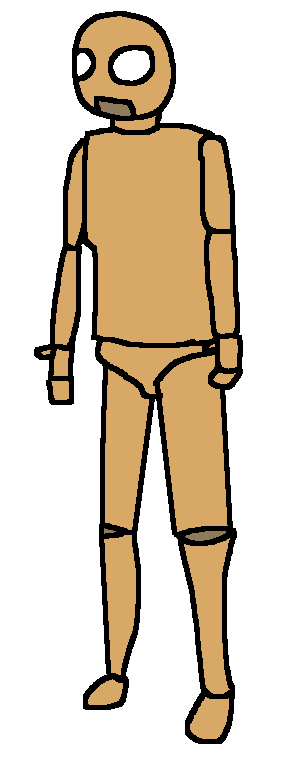
- Robustness: 3
- Number appearing: 1-8
- Disposition: Cautious
- Courage: Brave
- Soul color: Yellow and green mixed
- Intelligence: Mortal-like
Mechanids are constructs the Magellians used as guards, servants and soldiers. They have humanoid clockwork bodies made of pure brass, and they are animated by Mikton souls bound to jars affixed to their heads. Unlike War Puppets and Agalmaliths, Mechanids are tactically clever due to their capacity for advanced reasoning. Mechanids are magically compelled to obey their broad directive, even centuries after the Magellian Empire has collapsed. However, this obedience is moderated by a self-preservation instinct which allows them to retreat when survival serves their ultimate aims.
Mechanid soldiers are skilled with both melee and ranged weapons. The standard equipment for soldiers are one ray gun rifle, one crossbow with bolts, and one dagger. In combat they prefer to open by exhausting their ray gun blasts, follow up with their crossbows, then close in with daggers if necessary. Mechanids generally do not wear armor, as their entire brass bodies are as protective and durable as plate armor.
Mechanids are capable of automatically self-repairing minor dents and scratches to their exterior, as well as minor damage to their internal clockwork. This magical process occurs at nearly the same rate as healing similar injuries for a human being. However, this does not mean healing spells targeted at living things affect them differently than other constructs. Completely killing a Mechanid requires the destruction of its jar, but their self-repair cannot recover from catastrophic damage to their bodies such as the loss of limbs. In such cases, it is possible to repair a Mechanid manually, and Mechanids often possess knowledge of how to manually repair themselves and others. If a Mechanid's body is destroyed beyond repair but its jar is preserved, its soul sits idle in its jar for eternity until destroyed.
War Puppets
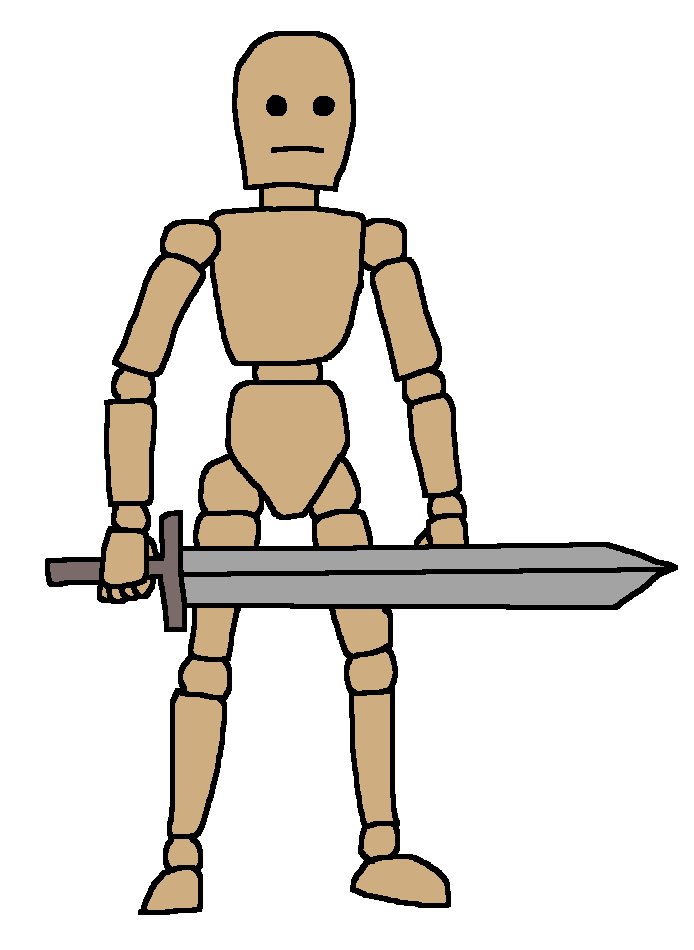
- Robustness: 2
- Number appearing: 1-4
- Disposition: Hostile
- Courage: Relentless
- Soul color: Yellow
- Intelligence: Automaton-like
War Puppets are life-sized humanoid wooden dolls, resembling marionette dolls but standing freely. The soul of a War Puppet is in a jar, affixed to its head. War Puppets are not intelligent, and can only follow simple commands without much ability to improvise. They generally wield melee weapons, and strike fiercely at their targets. War Puppets are one of the only constructs which enchanters of the Artisans Guild and the Academy of Knowledge are able to create. War Puppets commonly serve as stationary guards, bodyguards for travellers, and tools for dungeon explorers checking for traps.
Agalmaliths
- Robustness: 7
- Number appearing: 1-3
- Disposition: Hostile
- Courage: Relentless
- Soul color: Yellow
- Intelligence: Animal-like
The ancient Magellians knew how to construct enormous clockwork machines, which remain as guardians in their ruins. Some are giant humanoid statues, and others are shaped like vehicles of war. Agalmaliths are capable of greater autonomy in following its commands, compared to War Puppets. An Agalmalith's yellow soul is stored in a jar. If the Agalmalith is humanoid, its jar is affixed to its head.
Arketons
- Robustness: 9
- Number appearing: 1
- Disposition: Hostile
- Courage: Pragmatic
- Soul color: Yellow and green mixed
- Intelligence: Mortal-like
The ancient Magellians constructed enormous clockwork machines as weapons of war called Arketons. In order to enhance its intelligence and size, they were infused with several Mikton souls. However, the results were not predictable. While the resulting consciousness was more intelligent than the average of the constituent souls, the conflicting minds disoriented the being. Emotionally, Arketons were unpredictable and could lash out without apparent reason. Arketons were ultimately too unstable to be useful as weapons of war. Their physical form was oftentimes a mechanical clockwork dragon which could spew fire or acid, but other forms were constructed of similar size. An Arketon has four to six jars distributed throughout its body. Each jar that is destroyed gradually weakens the Arketon.
Stoicheioi
- Robustness: 10
- Number appearing: 1
- Disposition: Hostile
- Courage: Relentless
- Soul color: Yellow
- Intelligence: Animal-like
A Stoicheios is an artificial being made of a single pure element, one of fire, water, air, earth, sunlight, or moonlight. They are unstable, and prone to rampaging. However, due to their usefulness when tactically deployed in combat, the ancient Magellians sealed away armies of Stoicheioi in Ksylic spheres where they could be summoned at will. It was possible to temporarily phase a single Stoicheios out of its sphere to rampage against enemy armies, then phase it back into its sphere after its utility had run out. A Stoicheios possesses a jar at its core which contains its soul, and it is necessary to destroy the jar to destroy the Stoicheios.
Odioktons
- Robustness: 8
- Number appearing: 1
- Disposition: Cautious
- Courage: Relentless
- Soul color: Yellow and green mixed
- Intelligence: Mortal-like
The ancient Magellians bound Mikton souls to elemental air for use as covert assassins called Odioktons. They strike with blasts of the surrounding air to eliminate their targets. However, Odioktons are inherently defiant of their masters, and require powerful magic to remain under control. In order to keep these creatures under control, they were sealed away in Ksylic spheres. The summoner would phase the Odiokton out of the sphere, bind the Odiokton to force it to obey, then phase the Odiokton back into its Ksylic sphere upon completion of its task. However, Odioktons bound in this manner still had the ability to maliciously comply with its orders. An Odiokton possesses a jar at its core which contains its soul, and it is necessary to destroy the jar to destroy the Odiokton. This jar is completely invisible, as is the Odiokton as a whole, due to its composition being elemental air.
Undead Monsters
The undead are similar to artificial beings, in that their existence is almost always based on soul binding rituals granted by the Archon Igedeng. There are exceptions like Blood Monsters, which are spread by a disease and not soul binding. However, all undead creatures possess two universal traits: (1) their existence perverts the cycle of life and death, either spiritually or physically and (2) they are Cthonically corrupt.
A unique category of Undead are Ghosts. Certain ancestor veneration rituals feature a physical object that anchors the ancestor's soul, which is exactly the same type of object used for trapping souls in jars. Such rituals tend to create Ghosts, although the effect is not always obvious to those performing the ritual. Initially, this soul binding ritual has beneficial effects. Such Ghosts often have subtle presences, such as giving their venerators a feeling of warmth or protection. In such cases that the Ghost was intentionally bound, it may spiritually project a visible form and speak to offer wisdom to its venerator. Creating Ghosts is forbidden by the Imperial Cult. While Ghosts are benign at first, over the course of centuries Ghosts are corrupted by Igedeng's influence.
Once corrupted, the Ghost becomes restless and hostile to all surrounding mortals. The spiritual projection of a Ghost, being incorporeal, cannot be harmed by ordinary weapons. However, they may be harmed by enchanted weapons, elemental damage spells, and exorcism magic. When a Ghost's spiritual projection is defeated, it retreats into its jar. Finally releasing the Ghost requires the physical destruction of that same jar. There are several varieties of Ghosts, each with different abilities and appearances. All types of Ghost have a touch-based attack which drains the vitality of those who come into contact with their spiritual projections.
Blood Monsters
- Robustness: 7
- Number appearing: 1-6
- Disposition: Cautious
- Courage: Brave
- Soul color: Green core, with floods of red
- Intelligence: Mortal-like
Blood Monstrosity is a disease that spreads through contact with the blood of the infected. It is also possible to acquire Blood Monstrosity through the bite of the infected, but the risk is much lower. The time between contracting the disease and fatality varies between 24 hours and 1 week, but unless it's cured the infected spontaneously dies. Between transmission and death, the infected feels a sense of euphoria but is actually rapidly weakening. Regardless of whether the infected died spontaneously due to the disease, or if their death was externally caused, the infected person rises again as a Blood Monster with physical and mental alterations.
- They gain immense strength.
- If they do not feed on the blood of mortals, they die.
- They mostly appear as they did in life, but with sharpened carnivorous teeth, sharpened and hardened fingernails, pale skin, and red irises.
- They do not age.
- They are able to withstand the sunlight of dawn and dusk, but they are vulnerable to elemental sunlight attacks and die when exposed to the midday sun for several minutes.
- They can regenerate quickly from localized wounds, by means of their blood congealing around the wound to form a barrier.
- They retain the intelligence and memories they held in life.
- Their minds are polluted by the insatiable hunger for the blood of mortals.
- They are terrified of garlic, mirrors, and holy symbols of the Agathoi. This is completely psychological, and these objects do not physically harm or weaken them.
Due to its regenerative abilities, the clearest ways to defeat a Blood Monster after subduing it are to impale it through the heart with a sufficiently large object, decapitating it, or exposing it to the midday sun. Blood Monsters are aggressive physical combatants who may wield melee weapons, or otherwise use their teeth, fists, and claws. Blood Monsters grab their enemies in the middle of combat if the opportunity presents itself, and bite on their necks to feed. However, Blood Monsters will wait to feed if doing so exposes them to an attack. The Archon Eovumid is the original source of all Blood Monsters.
Liches
- Robustness: 10
- Number appearing: 1
- Disposition: Hostile
- Courage: Brave
- Soul color: Green core, with floods of red
- Intelligence: Mortal-like
Cthonic magic from the Archon Igedeng can anchor one's mortal soul to a jar, then reanimate the spellcaster's own flesh. In the case of Liches, this jar has the special name of phylactery. Liches no longer suffer to aging, hunger, or thirst. Over time, the flesh rots off their bones and they continue to live as a reanimated skeleton. When the physical body of a Lich is totally destroyed, its soul retreats to its phylactery and its body gradually regenerates from the surrounding elements. Liches have incredible magical abilities, and prefer to fight with spells instead of physical combat. Notably, all Liches have the ability to read minds. However, regardless of their original motivations to transform, a Lich's mind is polluted by the insatiable desire to extract enormous volumes of information. They tend to raise undead armies to attack villages, and bring living mortals back to their lairs. The Lich reads their minds, then extracts their bodies and souls as necromantic resources.
Corpsals
- Robustness: 3
- Number appearing: 2-8
- Disposition: Hostile
- Courage: Pragmatic
- Soul color: Green core, with traces of red
- Intelligence: Mortal-like
Those who prematurely seek to attain Lichhood are doomed to live as Corpsals. There are three steps which must be performed almost simultaneously to become a successful Lich:
- The spellcaster's soul is anchored to a jar.
- The spellcaster's body dies.
- The spellcaster's soul re-takes possession of the body, reanimating it.
A slight mistake in any one of these steps easily causes all three to fail. The result is that the soul remains anchored in the spellcaster's flesh, which sits halfway between life and proper reanimation.
The inferior binding process has several effects. First, they continue to require food and water to survive as they did in life. Second, their mind is damaged, severely stunting their magical power. Even so, Corpsals generally retain all the intelligence and memories they held in life, besides the capacity to perform magic. Third, their entire body is continuously rotting, requiring replacement with body parts from fresh cadavers. As a result, they spend their immortal lives searching for cadavers to sew onto their bodies to replace damaged parts. However, the transformation enhances their physical strength, making them formidable melee combatants.
Wraiths
- Robustness: 4
- Number appearing: 1
- Disposition: Hostile
- Courage: Relentless
- Soul color: Green core, with floods of red
- Intelligence: Mortal-like
Ghosts who died with unresolved intense hatred manifest as Wraiths. Their spiritual projections lack features of the deceased, but take the shape of shadowy humanoids. Sometimes their spiritual projections appear with images of weapons and armor, if the deceased was a warrior. However, these are just appearances and do not change their combat behavior. Wraiths do not have special abilities beyond the touch attack common to Ghosts.
Haunters
- Robustness: 5
- Number appearing: 1
- Disposition: Hostile
- Courage: Relentless
- Soul color: Green core, with floods of red
- Intelligence: Mortal-like
Haunters are very dangerous Ghosts who appear in large catacombs. They view themselves as guardians of the tombs they inhabit, and mortals who enter as intruders. The spiritual projection of a Haunter looks like a faint, flickering sillhouette. As with all Ghosts, Haunters have a touch attack. However, their true danger is the power to reanimate surrounding bodies into Zombies and Skeletons using Igedeng's magic.
Specters
- Robustness: 6
- Number appearing: 1
- Disposition: Hostile
- Courage: Relentless
- Soul color: Green core, with floods of red
- Intelligence: Mortal-like
Specters have one of two origins. The original Specter is most often a victim of murder, who seeks revenge against the killer. When a Specter kills a sentient mortal with its touch attack, the mortal killed may be automatically bound to an empty jar and immediately transformed into a Specter. That is the second origin of Specters.
Banshees
- Robustness: 7
- Number appearing: 1
- Disposition: Hostile
- Courage: Relentless
- Soul color: Green core, with floods of red
- Intelligence: Mortal-like
When an extremely vain, self-obsessed person becomes a Ghost, it manifests as a Banshee. Banshees appear as they did in life, but pale, translucent, and with horrifyingly twisted visages. Banshees always have an expression of anguish. Banshees can magically detect nearby living things, and harm their enemies with a powerful scream.
Dybbuks
- Robustness: 10
- Number appearing: 1
- Disposition: Hostile
- Courage: Relentless
- Soul color: Green core, with floods of red
- Intelligence: Mortal-like
A Dybbuk is a powerful Ghost who is obsessed with obtaining a corporeal form to settle unresolved issues in its past life. Accordingly, Dybbuks have the ability to possess the bodies of mortals. The Dybbuk's spiritual projection wrestles for control of its target, then takes control of the target's body. This displaces the host's soul into the jar. If either the Dybbuk is forced out of the host's body or the jar is destroyed, while the jar is also in proximity to the host's body, then the host's original soul safely returns to its own body unscathed. Otherwise, it is possible that the host's soul departs which kills the host.
Although Dybbuks prefer to immediately take possession of a host, they possess the touch attack common to all Ghosts. Their spiritual projections appear as they did in life, but with a slightly translucent body and glowing red eyes.
Skeletons
- Robustness: 1
- Number appearing: 3-18
- Disposition: Hostile
- Courage: Relentless
- Soul color: Red
- Intelligence: Automaton-like
Raising reanimated skeletons requires Cthonic magic to animate bones. This requires a skeleton that is more or less whole. They are not intelligent, and mindlessly obey the commands of their creators. The Archon Igedeng grants this power to his cultists. Skeletons often appear in large numbers and wield melee or ranged weapons to attack.
Zombies
- Robustness: 2
- Number appearing: 2-8
- Disposition: Hostile
- Courage: Relentless
- Soul color: Red
- Intelligence: Automaton-like
Raising reanimated zombies requires Cthonic magic to animate corpses. This requires a corpse with flesh that is more or less whole. They are not intelligent, and mindlessly obey the commands of their creators. The Archon Igedeng grants this power to his cultists. Zombies are very slow compared to skeletons, but they move silently. Zombies can scratch and bite to attack, but they are also capable of wielding melee weapons.
Misozonts
- Robustness: 5
- Number appearing: 1-4
- Disposition: Hostile
- Courage: Brave
- Soul color: Green core, with floods of red
- Intelligence: Mortal-like
Misozonts resemble humanoid skeletons made of an alloy of silver and bronze. In the past they were clockwork constructs, but Igedeng's corruption twisted their physical form. Their eyes glow red, and their fingers are elongated into sharp claws. A Misozont has a jar affixed to its metallic skull, containing its soul. If the Misozont's body is physically destroyed but the jar is preserved, its metallic body regenerates its destroyed metallic parts.
Misozonts are the terrible outcome of early experiments by the Magellian Empire, which sought to bind green souls to constructs. There were many iterations attempted, especially based on the theory that incorporating silver would counteract Cthonic corruption, but each attempt consistently resulted in catastrophic failure through Igedeng's corruption. This corruption took hold much more quickly than Ghosts, which appear benign for centuries. Instead, within a matter of weeks, Misozonts consistently broke down and became corrupted by Igedeng.
Misozonts retain all of their intelligence and memories they held in life. However, their minds are polluted by an unrelenting hatred of living, organic beings. Misozonts are not mindless brutes. They are capable of long-term planning in their ultimate goal to exterminate as much life as possible. The vast majority of Misozonts were destroyed by the Magellian Empire and long forgotten. However, some are still imprisoned in ancient Magellian ruins, and would become a tremendous danger if released.
In combat, Misozonts vary in their approach. They may use ranged weapons and set traps. However, most Misozonts prefer the thrill of striking with their claws in melee combat. They do not cast offensive spells, although Igedeng's magic grants specific abilities to them.
In the same way Misozonts can regenerate, Igedeng's magic also allows them to slowly fabricate the bodies of new Misozonts from the surrounding elements. Furthermore, Igedeng's magic grants them the ability to bind the souls of mortals they kill into jars and affixing those jars to the inanimate Misozont body. By these means, Misozonts have the potential to raise armies single-mindedly dedicated to the goal of killing mortals and capturing their souls into Misozonts.
